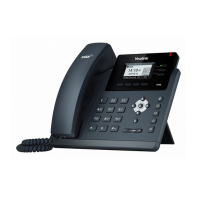Phone Network
5
Phone Network
Yealink IP phones operate on an Ethernet local area network (LAN) or wireless network. You can
configure the local area network to accommodate a number of network designs, which varies by
organization and Yealink IP phones.
Topics
IPv4 and IPv6 Network Settings
DHCP Option for IPv4
DHCP Option for IPv6
VLAN
Wi-Fi
Real-Time Transport Protocol (RTP) Ports
Network Address Translation (NAT)
Internet Port and PC Port
VPN
Quality of Service (QoS)
802.1x Authentication
TR-069 Device Management
IPv4 and IPv6 Network Settings
Yealink IP Phones support IPv4 addressing mode, IPv6 addressing mode, as well as an IPv4&IPv6
dual-stack addressing mode.
After connected to the wired network, the phones can obtain the IPv4 or IPv6 network settings from a
Dynamic Host Configuration Protocol (DHCP) server if your network supports it. To make it easier to
manage IP settings, we recommend using automated DHCP which is possible to eliminate repetitive
manually data entry.
You can also configure IPv4 or IPv6 network settings manually.
Yealink IP phones comply with the DHCPv4 specifications documented in RFC 2131, and DHCPv6
specifications documented in RFC 3315.
Topics
IP Addressing Mode Configuration
IPv4 Configuration

